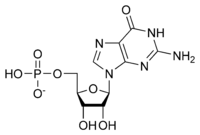User:Blandine Velut/Sandbox
From Proteopedia
m |
|||
| Line 49: | Line 49: | ||
1) L-glutamine + H2O --> L-glutamate + NH3 | 1) L-glutamine + H2O --> L-glutamate + NH3 | ||
<br />2) ATP + XMP + NH3 --> AMP + pyrophosphate + GMP | <br />2) ATP + XMP + NH3 --> AMP + pyrophosphate + GMP | ||
| - | |||
First, the glutaminase domain generates ammonia from glutamine-hydrolysis when L-glutamine binds to the catalytic triad. Then, an activation step prepares the XMP for amination. Indeed, GPM synthetase activates its XMP substrate by adenylylation on the xanthine C2 oxygen, which can then be primed for attack by a nitrogen nucleophile. In order to perform the second reaction, the glutamine-derived ammonia needs to be transferred to the <scene name='75/750228/Xmp/1'>XMP</scene>. This one is located in the active site of the synthetase domain, situated no far away from the catalytic triad. The ammonia translocation is enabled by a channel between the two active sites. This channel is formed thanks to a conformational change of the catalytic triad, further to its production. Thus, the activated XMP is aminated to produce GMP. Then, the GMP is released and will be used as a monomer in RNA. | First, the glutaminase domain generates ammonia from glutamine-hydrolysis when L-glutamine binds to the catalytic triad. Then, an activation step prepares the XMP for amination. Indeed, GPM synthetase activates its XMP substrate by adenylylation on the xanthine C2 oxygen, which can then be primed for attack by a nitrogen nucleophile. In order to perform the second reaction, the glutamine-derived ammonia needs to be transferred to the <scene name='75/750228/Xmp/1'>XMP</scene>. This one is located in the active site of the synthetase domain, situated no far away from the catalytic triad. The ammonia translocation is enabled by a channel between the two active sites. This channel is formed thanks to a conformational change of the catalytic triad, further to its production. Thus, the activated XMP is aminated to produce GMP. Then, the GMP is released and will be used as a monomer in RNA. | ||
Revision as of 19:21, 26 January 2017
2vxo
HUMAN GMP SYNTHETASE
An ample supply of nucleotides is essential for many life processes, including cell maturation, cell division and transmission of the genetic information. Indeed, nucleotides are the activated precursors of nucleic acids, but they also are major energy carriers, and precursors for the synthesis of nucleotide cofactors. Among these molecules is the guanosine monophosphate (GMP), also known as 5'-guanidylic acid or guanylic acid, a nucleotide that is used as a monomer in RNA. Like other nucleotides, GMP can be synthesized by 2 main pathways : de novo pathway and salvage pathway. De novo synthesis of nucleotide involves several enzymatic reaction and enzymes. Here, we will focus on the final step of the process, which is catalyzed by a glutamine amidotransferase called GMP synthetase (GMPS; E.C. 6.3.5.2). This enzyme belongs to the family of ligases, and catalyzes the conversion of xanthine monophosphate (XMP) to GMP in the presence of glutamine and ATP. [1]
| |||||||||||
References
- ↑ Oliver JC, Linger RS, Chittur SV, Davisson VJ. Substrate activation and conformational dynamics of guanosine 5'-monophosphate synthetase. Biochemistry. 2013 Aug 6;52(31):5225-35. doi: 10.1021/bi3017075. Epub 2013 Jul, 23. PMID:23841499 doi:http://dx.doi.org/10.1021/bi3017075


